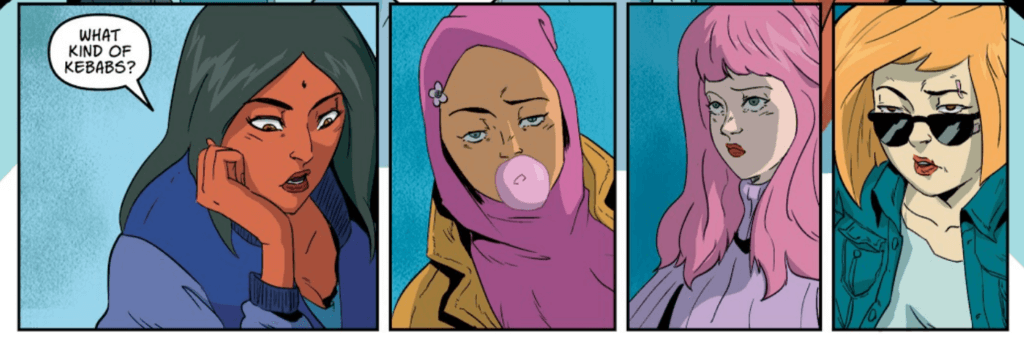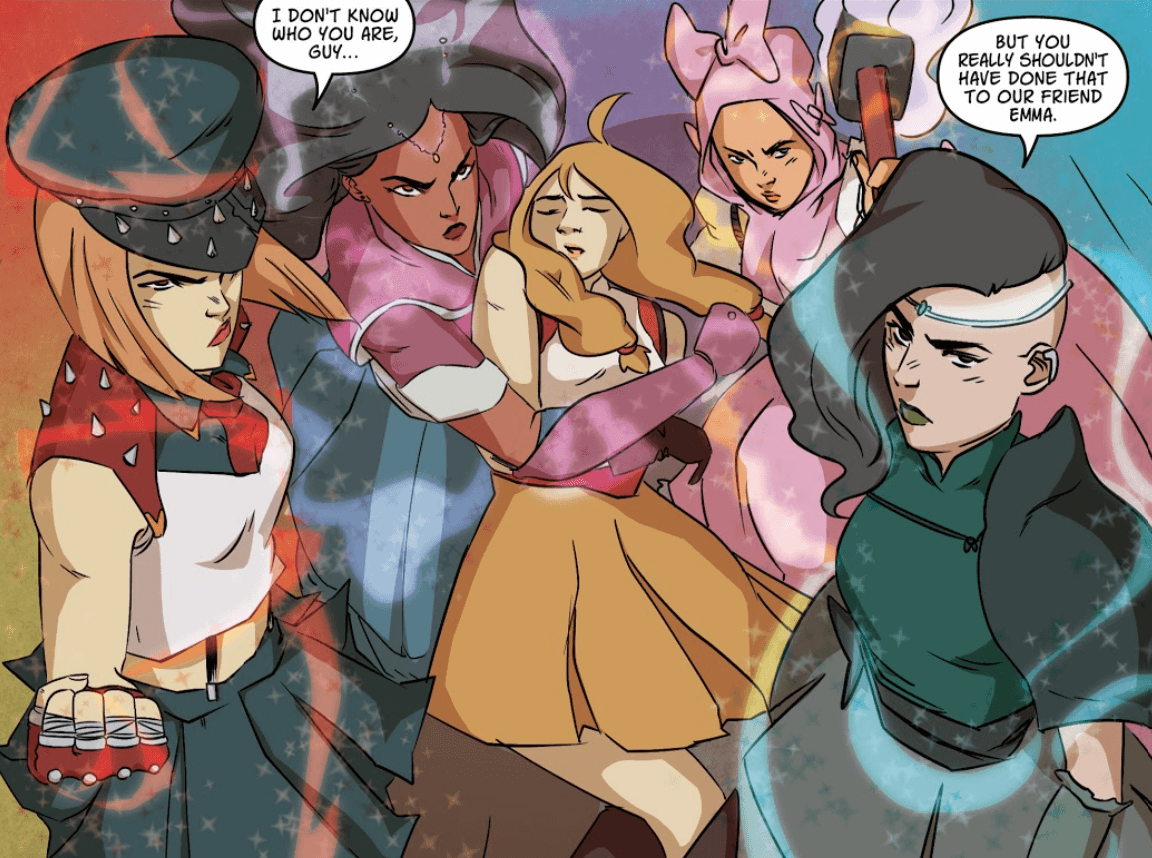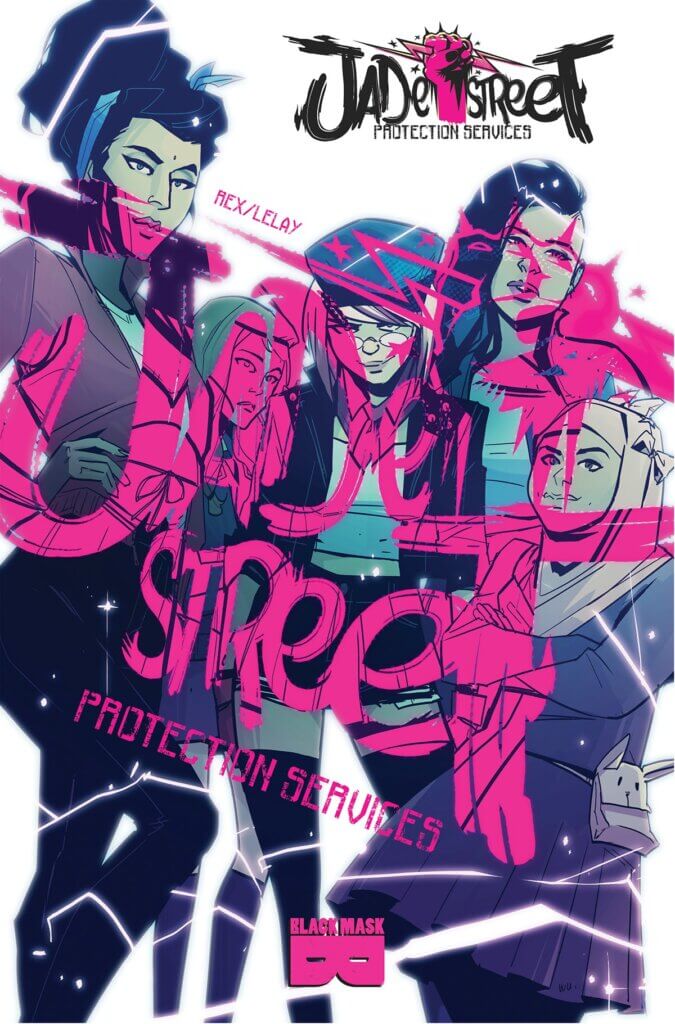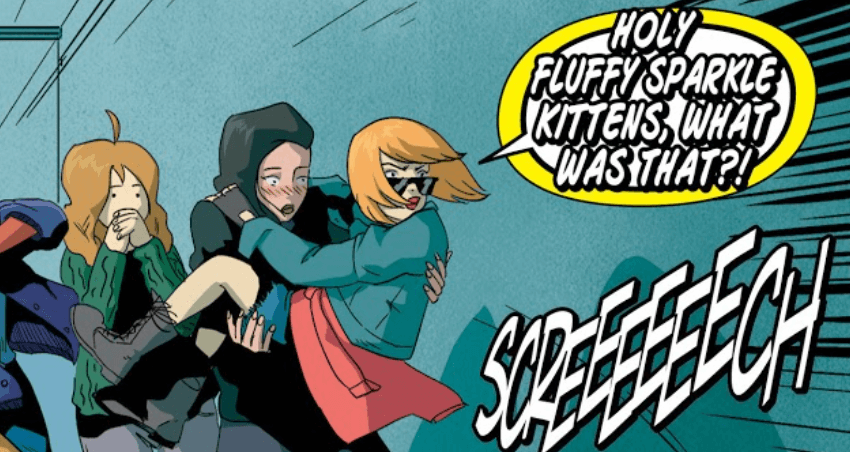One thing I love about Jade Street Protection Services is how much it emphasizes that all girls are magic. Some have more sparkles than others, and some move about the world differently, but they’re all championed as magical. And while the essence of this story is very rooted in the history of mahō shōjo manga (literally translating to magical girl, think Sailor Moon, Pretty Cure, etc.), the real beauty of this story is in how it defies these tropes to show how the protagonists of these stories are so often exploited.
Jade Street Protection Services Volume 1
Katy Rex (Writer), Fabian Lelay (Writer, Illustrator), Mara Jayne Carpenter (Colors), Taylor Esposito (Lettering), Annie Wu (Covers)
Black Mask Comics
September 1, 2020 (Originally published 2016-2017)
SPOILER WARNING: This article contains spoilers for Jade Street Protection Services #1.
Our heroes Divya, Saba, Noemi, Kai, and Emma are all students at Matsdotter Academy, a private school dedicated to training magical girls. This comes with all the tropes you might expect: mythical gemstones, elaborate transformations, a focusing item like a sword, hammer, or gun, and much more. The manga influence is apparent in a way that feels very much in homage to the shojo series it’s influenced by, and the creative team of Katy Rex and Fabian Lelay attempts to build off of the narrative rather than capitalizing on the aesthetic alone. In a rather harsh move by their teacher, the girls are all sent to detention for acting out, or not being in complete control of their powers.

In a scene reminiscent of The Breakfast Club, the girls become fast friends in detention and decide to leave to get food in the city of Yulong after realizing their teacher Mrs. Farro isn’t showing. The beauty of this series already shines through in the cast and their character interactions just from these few panels. Each of the five girls is very noticeably not white, along with a huge supporting cast of POC. The narrator of the story, Emma, is also pretty notable as one of the few well-thought-out depictions of a nonverbal autistic character that I’ve seen in comics. Very early on, the one character who’s blatantly ableist towards Emma for being nonverbal gets shut down by Noemi and Kai, with the whole crew taking steps to communicate with Emma by texting her.
When the Jade Street crew finds Mrs. Farro selling a magical item on the black market seemingly stripped from a girl, Moira, who didn’t show up for class that day, Emma springs into action, and the girls find themselves on the run from the place they just called home. All of this is just in the first issue, with each chapter bringing you closer to the magical girls and the magical world they live in. There’s something really endearing about hearing someone shout “holy sparkles!” or “r*ainbow gl*tter p*ppies!” to illustrate how much the world of Jade Street Protection Services is a world in which magic is just a part of everyday life.
While stylistically, this book takes heavy inspiration from classic mahō shōjo manga like Sailor Moon, I think the overall tone and messaging more closely resemble a critique of magical girl stories in the vein of Puella Magi Madoka Magica. Without spoiling the larger narrative of Madoka Magica (please watch it for yourself if you haven’t already), both of these stories have important things to say about how teenage girls are taken advantage of in service of being the idealized magical girl.
Throughout this story, the Jade Street girls regularly bring up the restrictions imposed on them by choosing to use magic, saying that “magical girls don’t make things” and putting an emphasis on focusing on items despite it only serving to limit their potential power. Part of the big reveal, along with realizing that Matsdotter is selling girls’ magic, is Mrs. Farro remarking about how Moira would “never make anyone a suitable wife”, suggesting that if they can’t be married off, then the girls aren’t fit to use their magic.
Jade Street Protection Services fights back against the commodification of the magical girls that we see on multiple levels throughout this story and continually tries to show how powerful Divya, Saba, Noemi, Kai, and Emma can all be. It’s a comic that doesn’t show them fighting despite their differences but champions how their different backgrounds and personalities make them all so important.
My only real critique is that I don’t have more to read, with only four issues to get to know these characters and wrap up this formative arc. It does a good job of finding time to flesh out all the characters, but I wish I could see how these characters develop over time as they figure out their paths as magical girls. Hopefully, Black Mask releasing this volume a few years after the original release will spark some new-found interest in what is easily one of the most interesting stories about magical girls that I’ve ever read.



